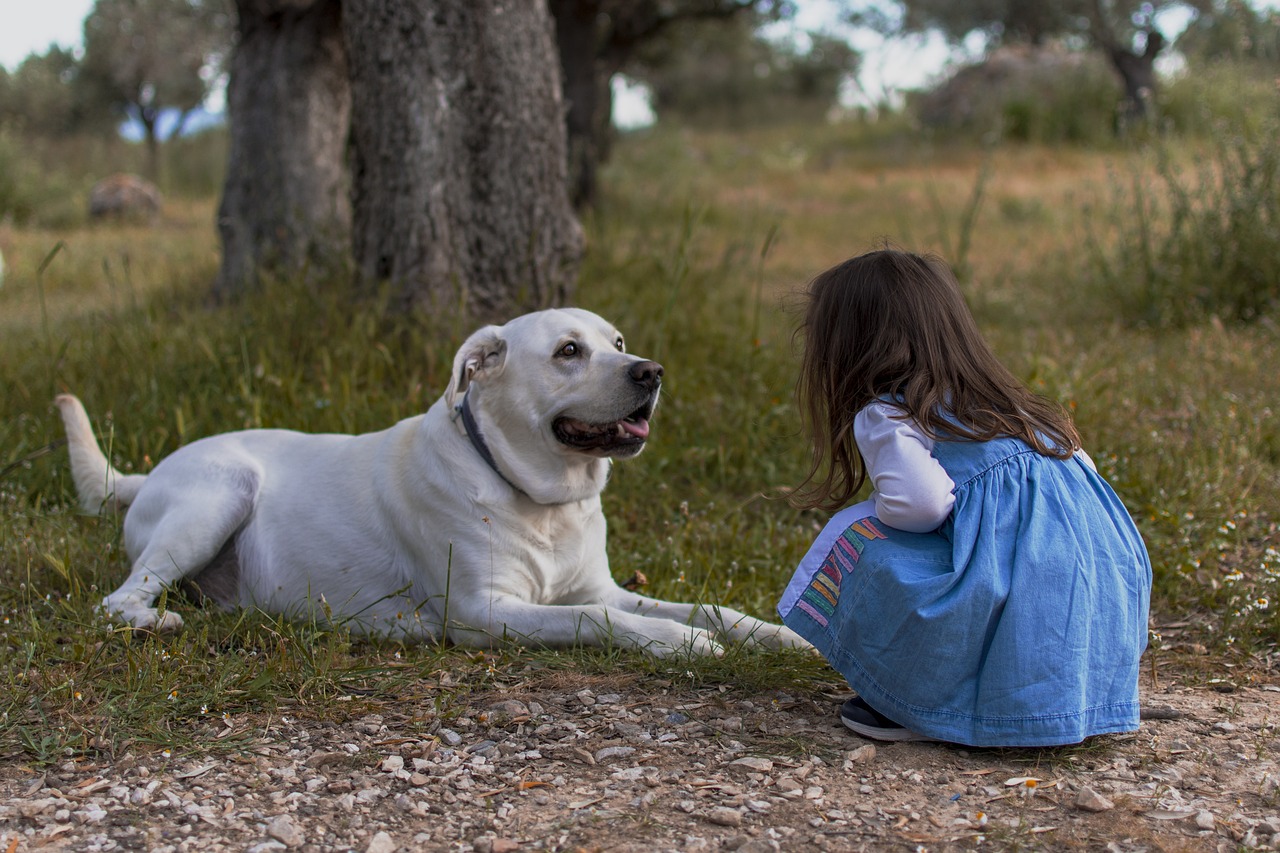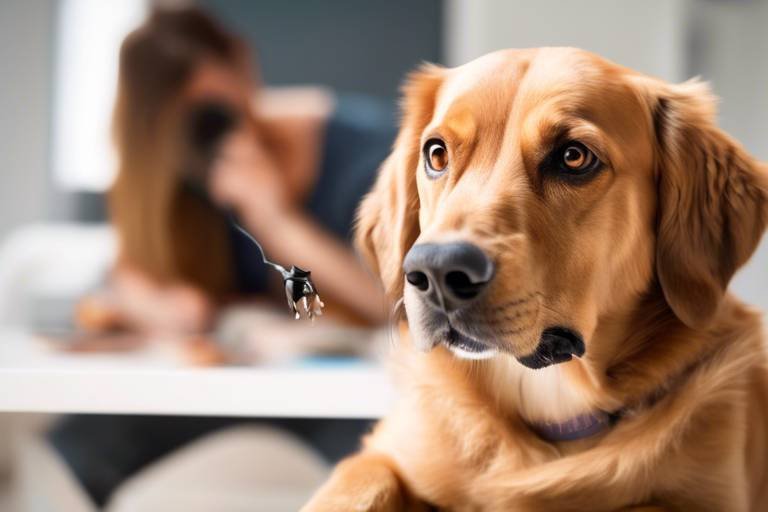The Benefits of Crate Training for Dogs
Crate training is more than just a method of confinement; it's a powerful tool that can transform your dog's behavior and enhance the bond you share. Imagine your furry friend seeing their crate not as a cage, but as a cozy haven where they can relax and feel secure. This article explores the numerous advantages of crate training for dogs, including behavioral improvements, safety, and the creation of a secure environment for both pets and their owners. By understanding and implementing crate training effectively, you can foster a happier, healthier, and more well-adjusted dog.
So, what exactly is crate training? At its core, crate training is about teaching your dog to view their crate as a safe space. Think of it as their personal sanctuary, a place where they can retreat when the world feels overwhelming. The importance of crate training in a dog's development cannot be overstated. It provides a structured environment that can help with various aspects of their behavior. Just like children benefit from having a designated play area, dogs thrive when they have a space that is exclusively theirs. This section will delve deeper into the fundamentals of crate training and why it is crucial for your pet's well-being.
One of the most significant advantages of crate training is the positive impact it can have on your dog's behavior. Dogs, like humans, can experience anxiety and stress, especially when left alone. Crate training can lead to significant behavioral improvements in dogs, helping to reduce anxiety, prevent destructive behavior, and establish a routine. Let's take a closer look at these benefits.
Many dogs experience anxiety when left alone, which can lead to unwanted behaviors such as excessive barking, chewing, or even house soiling. Crate training can help alleviate anxiety by providing a secure space for dogs during stressful situations. When introduced correctly, a crate becomes a safe haven where your dog can retreat to feel calm and protected. This is especially important during thunderstorms, fireworks, or when there are unfamiliar visitors in the home.
A crate serves as a personal sanctuary for dogs. Imagine having a room where you can go to unwind after a long day; that's what a crate can represent for your dog. By creating a positive association with the crate through treats, toys, and praise, you can help your pet view it as a comforting retreat during noisy or chaotic times. It's essential to ensure that the crate is a pleasant environment, filled with soft bedding and their favorite toys, so they feel at ease when they enter.
Crate training helps teach dogs boundaries within the home. Just like children need to learn limits, dogs benefit from understanding what behaviors are acceptable. By using the crate as a tool for boundaries, you can prevent unwanted behaviors such as jumping on guests, rummaging through the trash, or engaging in destructive chewing. This section highlights the importance of setting limits to maintain a harmonious household and ensure that your dog knows their place within the family structure.
Crate training is an effective tool for house training puppies. It teaches them where and when to relieve themselves, as dogs naturally avoid soiling their sleeping area. By using the crate to establish a routine, you can help your puppy learn to hold it until they are taken outside. This process involves taking your puppy out regularly and rewarding them for doing their business outside, reinforcing the desired behavior. With patience and consistency, your puppy will quickly grasp the concept of house training.
Using a crate can enhance the safety of both dogs and their owners. Just like a seatbelt keeps you secure in a car, a crate can prevent accidents and keep pets secure when necessary. This section discusses how crate training can minimize risks and ensure a safer environment for your furry friend.
Crate training minimizes the likelihood of accidents in the house. When you can't supervise your dog, a crate provides a controlled environment where they cannot get into trouble. This can significantly reduce messes while house training and keep your home tidy. Imagine coming home to a clean house instead of a disaster zone; crate training can help make that a reality!
Crate training prepares dogs for safe travel. Just as we buckle up for safety during car rides, dogs can benefit from being comfortable in their crates when traveling. Familiarizing your dog with their crate can make car trips and visits to new places stress-free for both pets and owners. It’s like having a portable safe space for your dog, ensuring they feel secure no matter where they go.
- Is crate training cruel? No, when done correctly, crate training is a humane way to provide a safe space for your dog.
- How long can I leave my dog in a crate? Puppies should not be crated for more than a few hours at a time, while adult dogs can typically stay in a crate for up to 6-8 hours, depending on their needs.
- What if my dog doesn't like the crate? It's essential to introduce the crate gradually and positively, using treats and praise to create a positive association.

Understanding Crate Training
Crate training is more than just a method; it's a pivotal journey in teaching your dog to perceive their crate as a safe haven. Imagine a cozy nook where your furry friend can retreat, much like we seek comfort in our favorite armchair or a warm blanket. This process involves gradually introducing your dog to the crate, making it a positive experience filled with treats, toys, and plenty of love. The goal is to create a space that your dog associates with security and comfort.
At its core, crate training is about understanding your dog's instincts. Dogs are den animals by nature, and a crate can mimic a den-like environment, providing them with a sense of safety. When done correctly, crate training can significantly contribute to a dog's overall behavioral development. It’s essential to approach this training with patience and consistency. Just like teaching a child to ride a bike, it takes time, encouragement, and a sprinkle of fun!
Here are some key aspects that highlight the importance of crate training:
- Safety: A crate can protect your dog from household dangers when you’re not able to supervise them.
- House Training: It aids in establishing a routine for bathroom breaks, helping your dog learn when and where it’s appropriate to relieve themselves.
- Travel Preparation: Familiarity with a crate makes your dog more comfortable during travel, reducing anxiety and stress.
Moreover, crate training is an excellent way to manage your dog's behavior. It sets clear boundaries, teaching them what is acceptable and what is not. Think of it as a gentle way to guide your dog through the maze of household rules. Just as we have rules at home, dogs thrive when they know their limits. And remember, the crate should never be used as a punishment; it’s a sanctuary, not a prison. If used correctly, your dog will learn to love their crate, seeing it as their own little world where they can relax and recharge.
In summary, understanding crate training is about recognizing its multifaceted benefits. It’s not just about confining your dog; it’s about creating a nurturing environment that fosters security and comfort. With the right approach, you can transform the crate into a beloved retreat for your furry friend, ensuring a happier and more harmonious household.

Behavioral Benefits
Crate training is not just about keeping your furry friend contained; it’s a powerful tool that can lead to significant behavioral improvements in dogs. When done correctly, it can transform your pet’s demeanor, making them more relaxed and well-adjusted. Imagine your dog, once a bundle of anxiety, now calmly lounging in their crate, a safe haven that they love. This transformation is not just a dream; it’s a reality for many pet owners who embrace crate training.
One of the most notable benefits of crate training is its ability to reduce anxiety. Many dogs experience stress when left alone, often leading to undesirable behaviors such as excessive barking, chewing, or even house soiling. By introducing your dog to a crate gradually, you can help them see it as a secure space rather than a form of punishment. Think of the crate as a cozy den—dogs are den animals by nature, and having a designated space where they feel safe can significantly alleviate their anxiety. When they’re feeling overwhelmed by loud noises or the hustle and bustle of a busy household, their crate can become a comforting retreat.
Furthermore, crate training is an effective method for establishing boundaries. Just like children, dogs thrive when they know the rules. By teaching them that certain areas of the home are off-limits, you can prevent unwanted behaviors and maintain a harmonious living environment. For instance, if your dog has a tendency to chew on furniture or get into the trash, a crate can help limit their access to these tempting targets. It’s like giving them a set of rules in a world full of distractions, helping them learn what is acceptable and what isn’t.
Moreover, crate training plays a crucial role in house training. Puppies, in particular, benefit immensely from this approach. When you confine your puppy to a crate, they naturally avoid soiling their sleeping area. This instinct can be harnessed to teach them where and when it’s appropriate to relieve themselves. It’s almost like having a built-in timer; when they’re let out of the crate after a certain period, they quickly learn that it’s time to go outside. This method not only helps with house training but also reinforces a routine that can be beneficial throughout their lives.
In summary, the behavioral benefits of crate training are profound. By providing your dog with a safe space, establishing boundaries, and assisting with house training, you’re setting the stage for a well-behaved and confident companion. So, if you’re considering crate training, remember that you’re not just teaching your dog to stay in a confined space; you’re giving them a sense of security and structure that will benefit both of you.
- Is crate training cruel? No, when done correctly, crate training is a humane way to provide your dog with a safe space.
- How long can I leave my dog in a crate? It depends on the age of your dog; puppies can typically hold it for one hour per month of age.
- Will my dog learn to love their crate? Yes, with positive reinforcement, most dogs will view their crate as a cozy retreat.
- What if my dog cries in the crate? It’s normal for dogs to cry initially; try to comfort them and gradually increase their crate time.
Reducing Anxiety
Many dogs experience anxiety, especially when left alone or during stressful situations like thunderstorms or fireworks. This anxiety can manifest in various ways, such as barking, chewing furniture, or even attempting to escape. Crate training can be a game-changer in this regard, acting like a cozy blanket that wraps around your pet, providing comfort and security. When introduced properly, a crate becomes a safe haven where your dog can retreat and relax, helping to alleviate their stress.
Imagine being in a crowded room where everyone is talking loudly, and you just want a quiet corner to gather your thoughts. That’s how your dog feels in chaotic situations. A crate can serve as that quiet corner—an escape from the hustle and bustle of daily life. When your dog learns that their crate is a peaceful place, it can significantly reduce their anxiety levels.
To help your dog associate the crate with positive experiences, you can use a few simple strategies:
- Start by placing the crate in a calm area of your home.
- Encourage your dog to explore the crate by placing treats or their favorite toys inside.
- Gradually increase the time they spend in the crate, always reinforcing with praise and rewards.
By following these steps, you’re not just training your dog to stay in a crate; you’re teaching them that this space is their own little sanctuary. Over time, they will begin to seek out the crate on their own during moments of stress, which is a clear indication that they feel safe and secure.
Moreover, crate training can also help with separation anxiety. Many dogs feel distressed when their owners leave the house, leading to destructive behaviors. By crate training, you teach your dog that it’s perfectly fine to be alone for short periods. This gradual desensitization can help them feel more comfortable when you’re not around, reducing their overall anxiety.
In conclusion, crate training isn’t just about keeping your dog contained; it’s about creating a positive environment that fosters security and tranquility. With a little patience and consistent effort, you’ll find that your furry friend can conquer their anxieties, leading to a happier and healthier life.
Creating a Safe Haven
When it comes to our furry friends, creating a safe haven is paramount. A crate can be more than just a confinement tool; it can transform into a sanctuary for your dog. Imagine your pet having a cozy little nook where they can retreat when the world becomes overwhelming. This is the essence of crate training—teaching your dog that their crate is a place of comfort and security rather than a prison. By introducing the crate in a positive light, you can help your dog associate it with feelings of happiness and relaxation.
To establish this safe haven, start by ensuring the crate is a welcoming environment. You can achieve this by adding soft bedding, favorite toys, and even a piece of your clothing to provide a familiar scent. This simple act can make a world of difference. Just like a child feels safe under their blanket, a dog will find solace in their crate. Moreover, it’s essential to practice positive reinforcement. Whenever your dog enters the crate willingly, shower them with praise or a treat. This creates a positive association, making them more likely to seek out their crate during stressful times.
Consider the crate as a personal retreat for your dog. In chaotic situations—like thunderstorms, fireworks, or even just a busy household—a crate can serve as a refuge. Dogs, much like humans, can feel overwhelmed by noise and commotion. By providing a crate, you’re offering them a place to escape the chaos, allowing them to feel safe and secure. It's crucial to remember that the crate should never be used as a form of punishment; instead, it should be a place where your dog can relax and recharge.
Furthermore, the location of the crate matters significantly. Placing it in a quiet corner of your home, away from high traffic areas, can enhance its role as a safe haven. You might also consider covering the crate with a blanket, which can create a den-like atmosphere that many dogs find comforting. Just like we enjoy a cozy corner of our homes, dogs appreciate having their own little hideaway.
In summary, creating a safe haven through effective crate training not only benefits your dog’s mental well-being but also enriches the bond between you and your pet. When your dog feels secure in their crate, they’re likely to exhibit calmer behavior and a greater sense of trust. So, invest the time and effort into making the crate a positive space. Your dog will thank you by feeling more confident and content in their environment.
- How long should my dog stay in the crate? It depends on the dog's age and training level. Generally, puppies should not be crated for more than a few hours at a time.
- Can I use the crate for punishment? No, the crate should be a safe space, not a place for punishment.
- What if my dog cries in the crate? It’s essential to differentiate between whining for attention and genuine distress. Gradually acclimate them to the crate and ensure they associate it with positive experiences.
- How can I make my dog love their crate? Use positive reinforcement, provide comfort items, and ensure the crate is placed in a quiet, safe location.
Establishing Boundaries
Establishing boundaries is a crucial aspect of crate training that can significantly improve your dog's behavior and your living environment. Think of the crate as a training tool that not only provides a safe space for your furry friend but also teaches them the limits of acceptable behavior within your home. Just like children, dogs thrive when they know what is expected of them, and crate training can help set those guidelines.
When you introduce your dog to a crate, you're not just giving them a place to sleep; you're also creating a structured environment where they can learn what areas of the house are off-limits. For instance, if your dog has access to the whole house, they might feel overwhelmed and may not know where to go or what to do. However, when you restrict their space initially, they begin to understand that certain areas are designated for specific activities—like sleeping, playing, or eating.
Moreover, establishing boundaries through crate training helps prevent unwanted behaviors such as chewing on furniture or getting into the trash. By using the crate as a time-out space, you can effectively redirect your dog's energy and curiosity. For example, if you catch your pup in the act of digging through the trash, a gentle correction followed by a short stay in the crate can reinforce the idea that certain behaviors are not acceptable.
Here are some key points to consider when establishing boundaries through crate training:
- Consistency is Key: Always use the crate as a place for positive reinforcement and never as a punishment. This helps your dog associate the crate with safety and comfort.
- Gradual Introduction: Start by allowing your dog to explore the crate on their own terms. Use treats and praise to encourage them to enter willingly.
- Short Stays: Begin with short periods in the crate and gradually increase the duration as your dog becomes more comfortable.
- Supervised Freedom: Once your dog understands the boundaries of their crate, you can slowly give them more freedom in the house while still monitoring their behavior.
By consistently reinforcing these boundaries, you not only help your dog feel secure but also promote a harmonious living environment. Remember, the goal is to create a space where your dog can thrive, and establishing clear boundaries is a significant step towards achieving that. In the end, a well-trained dog is a happy dog, and a happy dog makes for a happy owner!
House Training Assistance
When it comes to house training puppies, crate training is like having a secret weapon in your arsenal. Imagine this: you're a puppy, full of energy and curiosity, but you don't quite understand the rules of the house yet. Suddenly, your owner introduces you to a cozy crate, and it feels like a little fortress of safety! This is exactly how crate training works—it teaches your furry friend where it's appropriate to relieve themselves while also establishing a sense of security.
One of the primary reasons crate training is so effective for house training is that dogs instinctively avoid soiling their sleeping area. With this knowledge, you can leverage your pup's natural instincts to help them learn the ropes. When you place your puppy in their crate, they’ll quickly learn that they should wait until they're let outside to do their business. It’s like teaching them to hold their excitement until the right moment, which can be a game-changer for busy pet owners.
To make the most of crate training for house training, consistency is key. Here are a few tips to keep in mind:
- Regular Breaks: Take your puppy out frequently, especially after meals, playtime, and naps. This reinforces the idea that outside is the right place to go.
- Positive Reinforcement: Whenever your puppy relieves themselves outside, shower them with praise and maybe even a treat. It’s like throwing a mini celebration!
- Watch for Signs: Keep an eye on your puppy for signs that they need to go, such as sniffing around or circling. Quick action can prevent accidents.
Additionally, the crate can serve as a temporary holding area while you’re busy or away. Just remember, it’s not a punishment. The goal is to create a positive association with the crate so that your puppy sees it as their safe space. Over time, as they become more reliable, you can gradually increase their freedom around the house.
In summary, crate training not only assists in house training but also fosters a deeper bond between you and your dog. As they learn to understand the boundaries of their environment, you’ll find that both of you can enjoy a more harmonious living situation. And who wouldn’t want a well-trained pup that knows exactly when and where to do their business?
- How long can I leave my dog in a crate? Generally, puppies can hold it for about one hour for each month of their age, but adult dogs can usually stay in their crate for up to 8 hours.
- What if my dog cries in the crate? It’s important to determine if they need to go out or if they are just adjusting. Gradually acclimating them to the crate can help.
- Can crate training help with separation anxiety? Yes, crate training can provide a sense of security that may alleviate some anxiety when you leave your dog alone.

Safety and Security
When it comes to our furry friends, their safety and security are paramount. Crate training is not just a method for house training; it serves as a crucial tool in ensuring that both dogs and their owners can enjoy a worry-free environment. Imagine a world where you can leave your dog at home without fear of them getting into trouble or injuring themselves. That’s the magic of crate training! By introducing your dog to a crate, you create a designated space where they can feel secure, reducing the chances of accidents and mishaps that could occur when they roam freely.
One of the primary benefits of crate training is that it helps prevent accidents in the house. Dogs are naturally inclined to avoid soiling their sleeping area, which is why a crate can be a powerful ally in house training. When you use a crate properly, it can significantly minimize the likelihood of unwanted messes in your home. This means less stress for you and a cleaner living space. To illustrate this point, consider the following:
| Crate Training Benefits | Without Crate Training |
|---|---|
| Reduces accidents in the house | Increased messes and potential damage |
| Provides a safe space for the dog | Dog may get into dangerous situations |
| Establishes a routine | Inconsistent behavior and habits |
Moreover, crate training is a fantastic way to enhance travel safety. Have you ever taken a long car ride with a dog that just can't sit still? It can be quite the challenge! By familiarizing your dog with their crate, you can make travel a breeze. A dog that feels comfortable in their crate is less likely to become anxious during car rides, making for a smoother journey for both of you. When your dog is used to their crate, they will see it as a safe haven, even when you’re on the go. This not only keeps them secure but also allows you to focus on the road instead of worrying about your pup’s antics in the back seat.
In addition to travel, crate training is essential during times of chaos or when unexpected visitors arrive. Dogs can become anxious and stressed when faced with loud noises or unfamiliar faces. A crate provides a sanctuary for them during these moments. Instead of feeling overwhelmed, your dog can retreat to their crate, where they feel safe and secure. It’s like having a personal room where they can chill out and relax. This is especially beneficial for dogs that are naturally skittish or prone to anxiety.
In conclusion, crate training is a powerful tool for ensuring the safety and security of your dog. It not only helps in preventing accidents and providing a safe space at home but also makes travel easier and more enjoyable. So, if you’re considering crate training, remember that you’re not just teaching your dog to stay in a confined space; you’re creating a safe haven that they can rely on in various situations.
- Is crate training cruel? No, when done correctly, crate training provides a safe space for your dog.
- How long can a dog stay in a crate? Puppies should not be crated for more than a few hours, while adult dogs can typically stay in a crate for 4-6 hours.
- What if my dog cries in the crate? It's normal for dogs to cry initially. Gradual training and positive reinforcement can help them adjust.
- Can I use a crate for travel? Absolutely! Crates provide a secure environment for dogs during car trips.
Preventing Accidents
Accidents in the house can be a major source of frustration for both pet owners and their furry friends. Imagine coming home after a long day, only to find that your beloved pup has turned your living room into a disaster zone. Crate training can be a game-changer in this regard, acting as a proactive solution to prevent such mishaps. By introducing your dog to a crate, you create a controlled environment where they can feel safe and secure, significantly reducing the chances of accidents occurring.
When dogs are left unsupervised, their natural instincts may lead them to relieve themselves in places they shouldn't. However, when they are trained to see their crate as a comfortable and safe space, they are less likely to soil it. Dogs have a natural instinct to keep their sleeping area clean, which means that a properly introduced crate can help instill this behavior. Think of the crate as a cozy den; dogs naturally want to keep their dens tidy. This instinct can be harnessed to assist in house training, making it easier for you and your pet.
To maximize the effectiveness of crate training in preventing accidents, it's essential to establish a consistent routine. Regularly taking your dog outside after meals, playtime, and naps can help reinforce the idea of where it’s appropriate to relieve themselves. Additionally, keeping an eye on your dog’s behavior is crucial. If you notice signs that they need to go, such as sniffing, circling, or whining, promptly directing them to their designated potty area can prevent accidents before they happen.
Furthermore, understanding your dog’s age and breed can also play a significant role in preventing accidents. Puppies, for example, have smaller bladders and may require more frequent bathroom breaks. Here’s a quick reference table to illustrate the general potty training needs based on age:
| Dog Age | Potty Break Frequency |
|---|---|
| Puppy (up to 6 months) | Every 2-3 hours |
| Young Dog (6 months - 1 year) | Every 4-6 hours |
| Adult Dog (1 year and older) | Every 6-8 hours |
By adhering to these guidelines, you can significantly reduce the likelihood of accidents in your home. Remember, crate training is not just about confinement; it’s about creating a safe and structured environment that encourages good behavior. As your dog becomes more accustomed to their crate, you'll find that they begin to understand when and where it’s appropriate to relieve themselves, leading to a happier, cleaner home for both of you.
- How long can I leave my dog in the crate?
Generally, adult dogs can be crated for up to 8 hours, while puppies should not be crated for more than 3-4 hours at a time. - Will my dog hate the crate?
If introduced properly, most dogs come to see their crate as a safe space. Use positive reinforcement to create a positive association. - What if my dog cries in the crate?
It’s essential to differentiate between a need to go outside and whining for attention. If they need to go, take them out; if not, give them time to settle down.
Travel Safety
When it comes to traveling with your furry friend, ensuring their safety is paramount. Crate training plays a crucial role in preparing dogs for travel, transforming what could be a chaotic experience into a smooth and enjoyable journey. Imagine this: you’re on a road trip, the wind is in your hair, and your dog is happily nestled in their crate, feeling secure and calm. This scenario isn't just a dream; it can be your reality with proper crate training.
One of the biggest advantages of crate training for travel is that it helps your dog associate their crate with a positive experience. By regularly using the crate at home, your dog learns that it’s not just a place of confinement but a cozy retreat. This familiarity is crucial when you hit the road or board a plane. A dog that is comfortable in their crate is less likely to experience stress or anxiety during travel, which means a more pleasant experience for both of you.
Additionally, a crate can significantly enhance safety during travel. It serves as a secure enclosure that prevents your dog from moving around the vehicle or getting into trouble while you’re driving. Dogs that roam freely in a car can easily become a distraction, leading to potential accidents. By keeping your pet safely contained in their crate, you can focus on the road ahead, knowing that your dog is secure. Moreover, in the unfortunate event of an accident, a dog in a crate is less likely to be injured compared to one that is unrestrained.
Before embarking on a journey, it’s essential to get your dog accustomed to their crate. Start with short trips around the neighborhood, gradually increasing the duration as your dog becomes more comfortable. This gradual exposure helps to build positive associations with the crate and travel. You might even want to include some of their favorite toys or a familiar blanket to make the crate feel more like home. Always ensure that the crate is well-ventilated and large enough for your dog to stand, turn around, and lie down comfortably.
Lastly, don’t forget to consider the legal requirements and safety regulations for traveling with pets. Different states and countries may have specific rules regarding pet travel, including the need for health certificates or vaccinations. It's wise to do your homework before you travel, ensuring that you have all the necessary documentation and supplies. Here’s a quick checklist to keep in mind:
- Ensure your dog is microchipped or has a collar with an ID tag.
- Pack enough food, water, and bowls for the journey.
- Bring along any medications your dog may need.
- Include a leash and waste bags for potty breaks.
- Research pet-friendly accommodations ahead of time.
In summary, crate training not only prepares your dog for a safe journey but also fosters a sense of security and comfort. By making the crate a positive space, your dog will be ready to travel alongside you, turning every trip into an adventure filled with wagging tails and happy memories.
1. Is crate training safe for my dog during travel?
Yes, crate training is safe and can help keep your dog secure during travel, preventing distractions and potential injuries.
2. How do I get my dog used to the crate before a trip?
Start by introducing your dog to the crate at home, allowing them to explore it, and gradually taking them on short trips to build positive associations.
3. What size crate should I use for my dog?
The crate should be large enough for your dog to stand, turn around, and lie down comfortably. Consult size guides based on your dog’s breed and weight.
4. Can I use the crate for long road trips?
Absolutely! Just ensure to take regular breaks for potty and exercise, and keep your dog hydrated throughout the journey.
Frequently Asked Questions
- What is crate training and why is it important?
Crate training is a method that teaches dogs to view their crate as a safe and comfortable space. It's essential for a dog's development because it helps establish a routine, provides security, and can significantly reduce anxiety. Think of it as giving your dog their own little sanctuary where they can relax and feel at ease.
- How does crate training help reduce anxiety in dogs?
Many dogs feel anxious when left alone or during chaotic situations. Crate training offers them a secure environment where they can retreat to feel safe. Just like how we all have our cozy corners at home, a crate can become that special place for your furry friend, helping to ease their worries.
- Can crate training assist with house training?
Absolutely! Crate training is one of the most effective tools for house training puppies. Dogs naturally avoid soiling their sleeping area, so using a crate helps them learn when and where to relieve themselves, making the process much smoother for both you and your pup.
- Is it safe for my dog to be in a crate for long periods?
While crates can provide a safe space, it's important not to leave your dog in there for extended periods. Dogs need social interaction, exercise, and bathroom breaks. Think of the crate as a tool for short-term management rather than a long-term solution—just like how we wouldn’t want to be stuck in a room all day!
- How can I make my dog's crate a positive space?
To make the crate a positive environment, introduce it gradually and use plenty of treats and praise. Start by allowing your dog to explore the crate on their own. You can also place their favorite toys or a comfy blanket inside. The goal is to create a space they associate with good vibes and comfort, turning it into their personal retreat.
- Can crate training help with travel safety?
Yes! Crate training can significantly enhance travel safety for your dog. When dogs are familiar with their crate, they are more likely to feel secure during car rides or trips to new places. It's like having a portable safe zone that travels with them, making adventures less stressful for both you and your furry companion.
- What should I do if my dog resists going into the crate?
If your dog is hesitant about entering the crate, don’t force them. Instead, try to entice them with treats or toys. You can also leave the crate door open and let them explore it at their own pace. Patience is key here; it's all about making the crate a welcoming and non-threatening space for your pup.



















